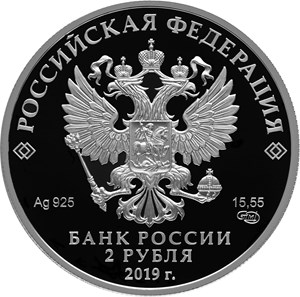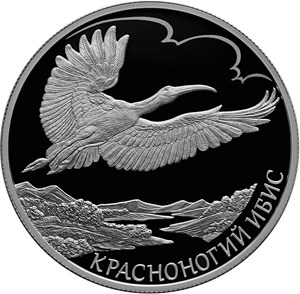Japanese Crested Ibis
Obverse
the mirror field of the disc bears a relief image of the National Coat of Arms of the Russian Federation, over it along the rim there is the semicircular inscription "РОССИЙСКАЯ ФЕДЕРАЦИЯ" (RUSSIAN FEDERATION) framed on both sides by doubled rhombuses, below under the coat of arms there are indications of the precious metal and its fineness on the left and the fine metal content and the mint trade mark on the right, at the bottom in the centre, in three lines, there is an inscription "БАНК РОССИИ" (BANK OF RUSSIA), the denomination of the coin "2 РУБЛЯ" (2 RUBLES), and the year of issue "2019 г." (2019).
Reverse
the mirror field of the disc bears a relief image of a flying Japanese crested ibis; at the bottom there is a semicircular inscription: "КРАСНОНОГИЙ ИБИС" (JAPANESE CRESTED IBIS).
Authors
The artists: E.V. Kramskaya (obverse), F.S. Andronov (reverse).
The sculptors: A.A. Dolgopolova (obverse), F.S. Andronov (reverse).
Mint: Saint Petersburg Mint (СПМД).
The edge: 195 corrugations.
Discover more
Series: Red Data Book
Japanese Crested Ibis
Catalogue number: 5110-0159
The crested ibis (Nipponia nippon) is a bird in the ibis family. It is critically endangered.
The crested ibis inhabits bogged up wide and flat river valleys in low mountains and plains with high forest areas. These birds spend the winter on non-freezing river stretches, and abandoned and waterlogged rice fields. They nest on high pine trees and in oak tree crowns.
In the late 19th century, the ibis was widespread in Central China, Japan and Russia’s Far East. The population started shrinking sharply at the turn of the 20th century, as the birds were hunted as game meat, shot as field wreckers (they trampled down rice crops), and poisoned with pesticides and fertilisers in rice fields. Besides, large trees where they nested and stayed overnight were fallen.
The latest mentioning of a crested ibis nesting in Russia dates back to 1917, and the latest mentioning of a single specimen was registered in 1990.
Source: http://www.mnr.gov.ru


